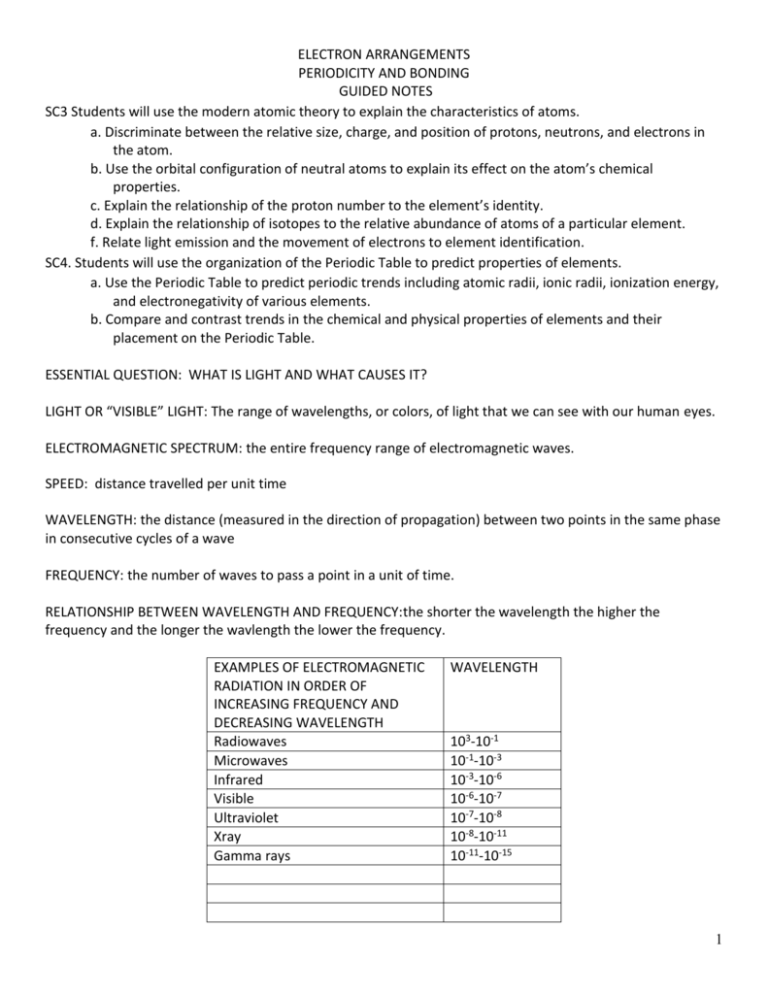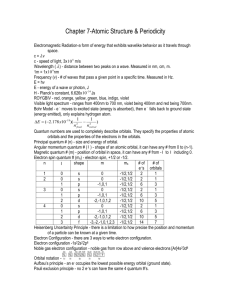Electron Arrangement Notes Packet ANSWERS
advertisement

ELECTRON ARRANGEMENTS PERIODICITY AND BONDING GUIDED NOTES SC3 Students will use the modern atomic theory to explain the characteristics of atoms. a. Discriminate between the relative size, charge, and position of protons, neutrons, and electrons in the atom. b. Use the orbital configuration of neutral atoms to explain its effect on the atom’s chemical properties. c. Explain the relationship of the proton number to the element’s identity. d. Explain the relationship of isotopes to the relative abundance of atoms of a particular element. f. Relate light emission and the movement of electrons to element identification. SC4. Students will use the organization of the Periodic Table to predict properties of elements. a. Use the Periodic Table to predict periodic trends including atomic radii, ionic radii, ionization energy, and electronegativity of various elements. b. Compare and contrast trends in the chemical and physical properties of elements and their placement on the Periodic Table. ESSENTIAL QUESTION: WHAT IS LIGHT AND WHAT CAUSES IT? LIGHT OR “VISIBLE” LIGHT: The range of wavelengths, or colors, of light that we can see with our human eyes. ELECTROMAGNETIC SPECTRUM: the entire frequency range of electromagnetic waves. SPEED: distance travelled per unit time WAVELENGTH: the distance (measured in the direction of propagation) between two points in the same phase in consecutive cycles of a wave FREQUENCY: the number of waves to pass a point in a unit of time. RELATIONSHIP BETWEEN WAVELENGTH AND FREQUENCY:the shorter the wavelength the higher the frequency and the longer the wavlength the lower the frequency. EXAMPLES OF ELECTROMAGNETIC RADIATION IN ORDER OF INCREASING FREQUENCY AND DECREASING WAVELENGTH Radiowaves Microwaves Infrared Visible Ultraviolet Xray Gamma rays WAVELENGTH 103-10-1 10-1-10-3 10-3-10-6 10-6-10-7 10-7-10-8 10-8-10-11 10-11-10-15 1 VISIBLE LIGHT (WHITE LIGHT) IN ORDER OF INCREASING FREQUENCY: “THE RAINBOW” Red, orange, yellow, green, blue, indigo, violet HOW CAN WE USE LIGHT EMISSION AND THE MOVEMENT OF ELECTRONS TO IDENTIFY AN ELEMENT IN A FLAME TEST? Each element releases an specific color or frequency which is how we identify elements in space. QUANTUM: quantum jump is a change of an electron from one quantum state to another within an atom. PHOTON: a photon is an elementary particle, the quantum of the electromagnetic interaction and the basic "unit" of light and all other forms of electromagnetic radiation. GROUND STATE: the lowest energy state of an atom or other particle. EXCITED STATE: particle that has a higher energy than that of its ground state ESSENTIAL QUESTION: WHAT ARE 3 IMPORTANT MODELS OF THE ATOM? THE WAVE MECHANICAL MODEL/QUANTUM MODEL OF THE ATOM 4 QUANTUM NUMBERS PRINCIPAL QUANTUM NUMBER: The number related to the amount of energy an electron has and therefore describing which shell the electron is in. 2 ANGULAR MOMENTUM QUANTUM NUMBER: the total angular momentum of a given particle, by combining its orbital angular momentum and its intrinsic angular momentum (i.e., its spin). MAGNETIC QUANTUM NUMBER: which describe the unique quantum state of an electron and is designated by the letter m. The magnetic quantum number denotes the energy levels available within a subshell. SPIN QUANTUM NUMBER: describes the spin orientation of an electron relative to an external magnetic field. ** WE WILL USE THIS MODEL OF THE ATOM TO STUDY ELECTRON ARRANGEMENTS AND TO DRAW ORBITAL NOTATIONS AND ELECTRON CONFIGURATION NOTATIONS FOR SPECIFIC ATOMS*** ENERGY LEVEL SUBLEVELS SPACE ORBITALS MAX. NUMBER OF OR SHELL ELECTRONS ST 1 1s 1 2 2ND 2s2p 3 8 3RD 3s3p3d 5 18 4TH 4s4p4d4f 7 32 5TH 5s5p5d5f5g 9 50 6TH 6s6p6d6f6g6h 72 7TH 7s7p7d7f 108 ESSENTIAL QUESTION: HOW IS THE ATOM LIKE AN APARTMENT BUILDING? RULES GOVERNING ELECTRON CONFIGURATIONS WHAT ARE THE RULES AND HOW ARE WE WILL USE THEM AUFBAU PRINCIPLE: Electrons occupy the lowest available energy level. THE DIAGONAL RULE: (insert a picture of the diagonal rule) 3 THE FILLING ORDER OF THE ELECTRONS IN THE ENERGY LEVELS 1s 2s 2p 3s 3p 4s 3d 4p 5s 4d 5p 6s 4f 5d 6p 7s 5f 6d 7p EXCEPTIONS TO THE FILLING ORDER: PERIOD 4: Cu AND Cr PERIOD 5: Mo – Ag (ALL) PERIOD 6: Pt AND Au WHY ARE THESE EXCEPTIONS TO THE FILLING ORDER? They are multivalent and can have fewer or more electrons. PAULI’S EXCLUSION PRINCIPLE: only two electrons with opposite spin can occupy an atomic orbital HUND’S RULE: electrons fill each and all orbitals in the subshell before they pair up with opposite spins. THREE WAYS TO SHOW ARRANGEMENTS OF ELECTRONS ORBITAL CONFIGURATION NOTATION: This uses the arrows and dashes. MAKE A CHART ON YOUR OWN TO SHOW THE ELECTRON ORBITAL CONFIGURATION NOTATIONS FOR ELEMENTS 1-36. ELECTRON CONFIGURATION NOTATION: this uses numbers and letters to represent the energy level, types of orbital and the number of electrons in the orbital. 4 EXAMPLE: ELECTRON DOT NOTATION: each valence electron is represented by a dot around the symbol of the element. EXAMPLE: NOBLE GAS CONFIGURATIONS: MAKE A CHART ON YOUR OWN PAPER AND ATTACH TO THE NOTES. symbol electron configuration helium He 1s2 neon Ne [He]2s22p6 argon Ar [Ne]3s23p6 krypton Kr [Ar]3d104s24p6 xenon Xe [Kr]4d105s25p6 radon Rn [Xe]4f145d106s26p6 VALENCE ELECTRONS VALENCE ELECTRONS: electrons located in the outside energy shell. 5 VALENCE NUMBERS/OXIDATION NUMBERS: The charge which an atom of the element has, or appears to have, in a compound. The number of electrons an atom gains or loses. GUIDED INSTRUCTION LIST THE # OF VALENCE ELECTRONS AND THE VALENCE NUMBER/OXIDATION NUMBER FOR THE FOLLOWING ATOMS ATOM #VALENCE ELECTRONS OXYGEN CHLORINE SODIUM POTASSIUM ALUMINIUM NITROGEN HYDROGEN CALCIUM LITHIUM FLUORINE SULFUR PHOSPHOROUS VALENCE #/OXIDATION # -2 -1 +1 +1 +3 -3 +1 +2 +1 -1 -2 -1 GROUP VALENCE ELECTRONS VALENCE # FOR GROUP 1 1 +1 2 2 +2 13 3 +3 14 4 +/-4 15 5 -3 16 6 -2 17 7 -1 18 8 0 OCTET: DEFINE: an atom wants 8 electrons to become stable. PERIODICITY STATE THE PERIODIC LAW: states that the repeating chemical and physical properties of elements change periodically with the elements atomic number. DRAW A GRAPHIC ORGANIZER TO ILLUSTRATE THE PERIODIC TREND FOR ELECTRONEGATIVY OF THE ELEMENTS ON THE PERIODIC TABLE (DESCRIBE THE TREND LEFT TO RIGHT ACROSS A PERIOD AND DOWN IN A GROUP) Atomic Radius Decreases Ionization Energy Increases Electronegativity Increases 6 WHICH CATEGORY OF ELEMENTS TENDS TO HAVE THE HIGHEST ELECTRONEGATIVITY AND WHICH GROUP TENDS TO HAVE THE LOWEST ELECTRONEGATIVITY? WHY? Group 17 highest: the ionization energy is high and the atomic radius is smaller. Group 1 lowest: the ionization energy is lower and the atomic radius is larger. ATOMIC RADIUS: is a measure of the size of its atoms, usually the mean or typical distance from the nucleus to the boundary of the surrounding cloud of electrons. DRAW A GRAPHIC ORGANIZER TO ILLUSTRATE THE PERIODIC TREND IN ATOMIC RADIUS OF THE ELEMENTS ON THE PERIODIC TABLE. LEFT TO RIGHT ACROSS A PERIOD AND DOWN IN A GROUP. IONIZATION ENERGY: Amount of energy required to remove the highest-energy electron from an isolated neutral atom in the gaseous state DRAW/INSERT A PICTURE OR A GRAPHIC ORGANIZER TO ILLUSTRATE THE PERIODIC TREND IN IONIZATION ENERGY OF THE ELEMENTS ON THE PERIODIC TABLE LEFT TO RIGHT ACROSS A PERIOD AND DOWN IN A GROUP. BLOCKS ON THE PERIODIC TABLE “S” BLOCK: The s orbital is a spherically-shaped region describing where an electron can be found “P” BLOCK: is a dumbbell-shaped region describing where an electron can be found “D” BLOCK: there is a set of five d orbitals (with more complex shapes and names) as well as the 3s and 3p orbitals (3px, 3py, 3pz). “F” BLOCK: the lanthanide and actinide series…very complex. USE THE BLOCKS ON THE PERIODIC TABLE, GROUP NUMBERS, PERIODS AND VALENCE ELECTRONS TO QUICKLY DETERMINE THE “OUTER ENERGY LEVEL CONFIGURAION” OF SPECIFIC ATOMS. 7 NAME THE ELEMENT GAME P BLOCK ELEMENT PERIOD 4 AND GROUP 15: NAME IT___________ S BLOCK ELEMENT PERIOD 2 AND GROUP 1: NAME IT_________ NAME THE “P” BLOCK ELEMENT WITH THE FOLLOWING OUTER ENERGY LEVEL CONFIGURATION: 5S2 5P2 NAME IT _______________ 8 “D” BLOCK ELEMENTS ( TWO POSSIBLE) 4 S1 NAME THEM _____________________ OR ___________________ “f” BLOCK ELEMENT: PERIOD 6 4 f 5, 6 s2 NAME IT:_______________ “f” BLOCK ELEMENT: PERIOD 7: “s” BLOCK ELEMENT: 5 S2 6d2, 7s2 NAME IT__________ NAME IT ______________________ “p” BLOCK ELEMENT: 4 S2, 4 P6 NAME IT ______________________ GIVE THE OUTER ENERGY LEVEL CONFIGURATION FOR THE FOLLOWING ELEMENTS USING THE BLOCK, PERIOD AND GROUP METHOD> ZINC _______________ OXYGEN_____________ CALCIUM ________________ KRYPTON _______ URANIUM _______________ SILVER _________ 9








